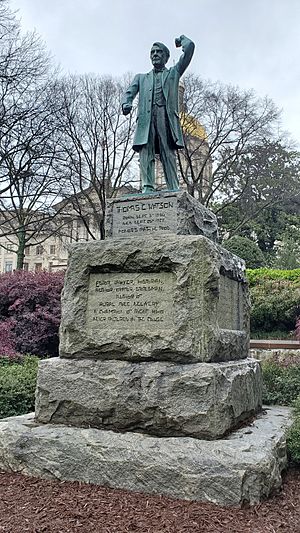Statue of Thomas E. Watson facts for kids

Thomas E. Watson statue (2020)
|
|
| Location | Talmadge Plaza, Atlanta, Georgia |
|---|---|
| Designer | Joseph Klein |
| Height | 12 feet (3.7 m) |
| Dedicated to | Thomas E. Watson |
The Thomas E. Watson statue is a public monument located near the Georgia State Capitol in Atlanta, Georgia. This statue was put in place in 1932. It honors a Georgian politician named Thomas E. Watson. He served in the United States Congress as both a Representative and a Senator. This was in the late 1800s and early 1900s. The statue was first on the steps of the capitol building. In 2013, it was moved to a nearby plaza.
Who Was Thomas E. Watson?
Thomas E. Watson was a politician from Georgia. He was born on September 5, 1856. Early in his career, he spoke out against certain injustices. He also supported giving African Americans the right to vote. He served in the Georgia General Assembly. He was also a U.S. Representative for Georgia.
Later in his life, his views changed. He ran for president in 1908 for the People's Party. By this time, he had become a strong supporter of certain controversial ideas. He also expressed views that were seen as unfair to some groups of people. He died on September 26, 1922, shortly after being elected to the United States Senate in 1920.
Why Was the Statue Built?
On August 21, 1925, the Georgia General Assembly decided to build a monument for Watson. They wanted it on the grounds of the Georgia State Capitol. Joseph Klein, a sculptor from Atlanta, designed the monument. It was officially dedicated on December 4, 1932. The statue was first placed on the steps on the west side of the capitol building.
Why Was the Statue Moved?
In October 2013, Georgia Governor Nathan Deal ordered the statue to be moved. It was taken from the capitol steps and placed in a plaza nearby. This decision was made during a big repair project on the building's west steps. Moving the statue permanently, instead of just for a short time, saved a lot of money. It was estimated to save between $50,000 and $60,000.
The statue was removed from the capitol steps on November 29, 2013. Many groups supported this move. These included the Anti-Defamation League and civil rights leaders. However, some groups, like the Sons of Confederate Veterans, did not agree. They said it was an attempt to "rewrite or cover up history." Former Georgia Governor Roy Barnes also supported the move. He said he wished he had moved it when he was governor.

